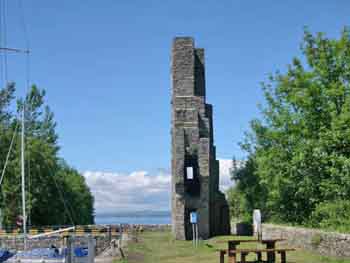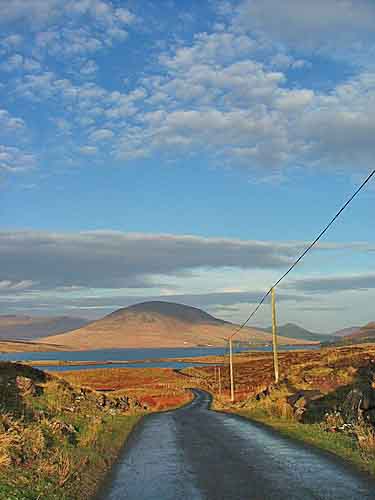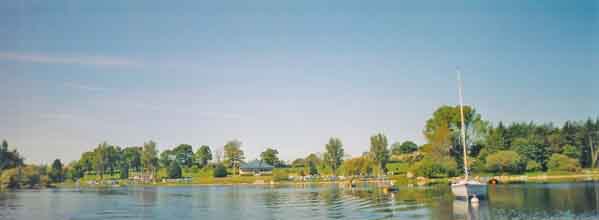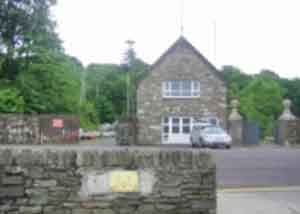Displaying items by tag: Yachting
Lough Swilly Yacht Club

Above: the crew of Cork at the beginning of the Clipper Race 2009
Lough Swilly Yacht Club
Lough Swilly Yacht Club is based in Fahan Creek on the shores of Lough Swilly, Co Donegal, three miles from Buncrana and ten miles from Derry.
Our membership consists of IRC-racing and cruising sailors as well as powerboat enthusiasts and some keen dinghy sailors. All club members enjoy spending time pottering about on the lough and many like to venture further afield; either to cruise or to represent the club in competition (see the Ships' Blog section for more).
Club History
The Lough Swilly Yacht Club was founded in February, 1955, when a meeting took place in the old City Hotel, with a view to forming a 'club' to encourage sailing and power boating in Lough Swilly by every possible means.
The first Officers of the club were: Commodore Dr. T.E. Hastings. Vice Commodore James McColgan. Rear Commodore Stephen Faller. Secretary Mayne Elliot and Treasurer Norvall Watt. A Committee was set up of men who between them had a wealth of sailing experience and whose enthusiasm and sheer hard work laid the firm foundation of today's thriving club.
The club was fortunate to have as a founder member Mr. James Whyte, Manager of the Lough Swilly Railway Co. and when the railway line from Derry to Buncrana closed in 1953 the club was able to purchase for a very nominal sum the old station waiting room and ticket office, as well as a considerable amount of ground where the old railway line ran beside the water's edge. This formed the nucleus of the present club and in subsequent years the slipway was built and extended, the caravan site erected and the clubhouse itself took in the old station house.
The first racing took place at 3.30pm (Swilly time) on Opening Day, Saturday 2nd July 1955, and there was a fine turnout of miscellaneous craft. After the day's racing all members and friends were invited to afternoon tea at the temporary club premises on the Railway Station Platform in Fanad, durning which prizes were awarded.
(The above information and image courtesy of Lough Swilly Yacht Club.
Lough Swilly Yacht Club, c/o Karen Sleat, Fahan, Lifford, Co Donegal. Email: [email protected]
Garrykennedy Sailing Club

Garrykennedy Sailing Club
Garrykennedy Sailing Club was founded in The Barge Inn, Garrykennedy (now Larkins) in the first week of September 1985. The subscription was set at £5 and twenty people became members. Willie McGrath was the first Commodore. The first series prize was donated to the club by Joe Reynolds in memory of the late Eddie Regan and was sailed for in October of that year. The boats sailing ranged in length from 17ft to Jubilee B at 33ft. During that series there were about 12 boats in the fleet.
Left: Garrykennedy Castle
(The above information and image courtesy of Garrykennedy Sailing Club)
Garrykennedy Sailing Club c/o Jim Hughes, Garrykennedy, Portroe, Nenagh, Co Tipperary. Tel: 067 23001, email: [email protected]
Have we got your club details? Click here to get involved
Foynes Yacht Club

Foynes Yacht Club
Foynes Yacht Club was founded in 1962, it has a modern club house with good facilities, bar, showers, changing rooms, kitchen and dance floor. Floating pontoons and deep water moorings allow ease of access to boats at all stages of the tide. Racing every Wednesday evening during the season. Membership is open to all, and Juniors are especially welcome.
Foynes Yacht Club – Its settings and origins – by R.J. Scott, 1991
In the age of commercial sail right up to the 1914–18 War, the Shannon Estuary was used regularly by coasting schooners and the like. Records show a considerable use of quays at Kilrush, Foynes, Kiladysert by these fine old wooden vessels. In fact, the Clare river (Fergus) was worked right up to Clarecastle in schooners and brigantines carrying as much as 320 tons of coal on 12.5 ft. draft, and that often without power other than flax, wind, a damn good kedge anchor and an even better six-man crew! Within the Estuary, as recently as 1954, the final cargo under sail was carried from Limerick when the late Johnny Davis put his 25-ton cutter Alzina on the mud at Labasheeda for the last time. Today motor craft have taken over from seagoing sail, fewer but bigger, and the lower Shannon sees them in all shapes of increasing ugliness, from 500 to 170,000 tons. In an age where carrying capacity is god and aesthetic beauty of line no longer of value in complex Balance Sheets, estuary craft like the Alzina, Edgar, Lahloo, Baron Joss, Mary Joseph and others have surrendered to the economics of road transport.
The traditions of sail have been passed on and nurtured to a degree by yachtsmen the world over. Yet strangely, the Shannon Estuary appeared to lose much of this contact, that is apart from a comparatively few individuals, hardly more than a dozen or two at one time between 1920 and 1962. Perhaps the best known figure of this era was the late Conor O'Brien of Foynes who, fifty years ago this year (1991), sailed round to Dublin and took his departure on 23rd June in his 20-ton Baltimore-built ketch Saoirse. Exactly two years later to the day, he arrived back to a massive welcome having circumnavigated the world. His craft was the first to carry the new Irish tricolour round the globe. Conor's writings are widely read and his home may still be seen, set amongst the trees on Foynes Island.
It was inevitable, of course, that with the increasing popularity of yachting on other coasts the pastime should develop in the Estuary. In July, 1962 seven boat-owners, five from Limerick, one from Foynes and one from Newcastle West,got together in a Foynes local and simply formed a club. So Foynes Yacht Club was born. For the record, the seven founders were: Dan O'Sullivan (Commodore), Dick Nash (Secretary), Peter Lawless (Treasurer) with Peter McKenna, Pat Dinneen, Joe Bottcher and Roger Bourke.
From this small beginning Foynes Yacht Club had grown to a membership of one hundred and eighty by 1973. That year marked a long sought milestone, the opening of the new clubhouse. With it's 250ft boat slip built by members in 1971, it gave Foynes and the lower Shannon Region it's first major water based leisure facility.
Coincidentally, the West of Ireland Offshore Racing Association's Annual Championship for Cruisers, also established 1973, has been hosted successfully every third year by the club since then.
Dublin Bay Mermaids were very popular in the club during the early seventies, declined almost to extinction in the eighties, but have returned more popular than ever in the nineties. But, if the Mermaids numbers declined, interest by Mermaiders in Foynes didn't and the Mermaid National Championship was hosted by the club in 1973, 1977, 1984 and 1989 and is again scheduled for 1993. Meanwhile the club instituted The Munster Mermaid Championship in 1990 as an annual event which even attracts boats from the east coast to participate.
Perhaps the busiest year for the club was 1989 when it hosted a GP14 Championship in May, the West of lreland Offshore championship in July, the Mermaid Nationals in August and then revived the town Regatta in September. The club continued to improve by developing its facilities, reclaiming and rockfacing the foreshore, extending and paving the dinghy and car parks and widening the slipway. The Club constructed the first Marina on the west coast, a development which is being considerably extended and improved this year. Plans are also in hand to improve the clubhouse.
And today's club...
The river Shannon is the longest river in the British isles. It rises in Co Cavan and enters the Atlantic ocean in the southwest of Ireland. It is tidal west of Limerick city. It's estuary has a tidal range of over 5 metres and it can run at over 4 knots in places.
Foynes is located in the southwest of Ireland on the southern shore of the Shannon estuary on a channel formed by Foynes Island. It has a very busy commercial port and to the west of this Foynes Yacht club. It is about 25 miles west of Limerick city on the N69.
In the club there are about 12 yacht over 9 metres, eight in the 7–9 metre range and about ten active mermaids plus other dinghies. We race every Wednesday evening during the summer months and on Sundays in September as well as some annual weekend events. In all there are just over 130 members.
Our facilities include a modern clubhouse with bar, dance floor, toilets and showers.
We have a pontoon which can accommodate approximately eight visiting boats, four club boats, the club crashboat and 12 dinghies.
All other boats are kept on swinging moorings on the east side of Foynes island. Additionally there is a wintering compound for 30 yachts and a launching slip.
(The above information and image courtesy of Foynes Yacht Club)
Foynes Yacht Club, Cooleen Point, Foynes, Co. Limerick. Tel 353 62 65261
or
c/o Elaine O' Mahoney, Coolen Point, Foynes, Co Limerick. Tel: 069 65261, email: [email protected]
Have we got your club details? Click here to get involved
Dungarvan Harbour Sailing Club

Dungarvan Harbour Sailing Club
Dungarvan has always been noted for its sailors and its great sea-faring families and the tradition of the bygone days of the coastal schooners is reflected there today in the strong active sailing club which was founded at a public meeting in the Town Hall on Friday 2nd August 1946. The first officers were Bernard Mulcahy, Commodore, Reveille Farrell, Vice Commodore, Maurice Kiely, Secretary and Joe Donovan, Treasurer.
Left: The Clubhouse
The inaugural race of the club, for the newly presented Mulcahy Cup, was held over a 6½ mile course with a fleet of four boats; Mairead built by Tyrells and owned by Bernard Mulcahy, Maise formerly of Dublin owned by Maurice and Peter Kiely, Naomh Breandáin owned by Gerard Walsh, and Jane Shore owned by James Villiers Stuart. The race was won by Maurice and Peter Kiely.
Helvick based boats then showed an interest and these craft, mostly gaff rigged salmon boats crewed by fishermen from the Helvick and Ring Gaeltacht, were usually well placed. Amongst these 'Pauls Boat' and 'Slatterys Boat' were outstanding, leaving the 'yachts' a poor second on more than one occasion.
In 1948 Reveille Farrell bought Susanna, a nine-ton Bermudan cutter designed by Norman Dallimore and built in 1936. She was to become well known for her many cruises to the West Coast of Ireland, in the English Channel, and Brittany. The most famous of these was in June 1957 when accompanied by Gerard Walsh and John Ballot she sailed to Spain and back. This was a considerable achievement at the time as it was believed that the passage across the Bay of Biscay and back again was beyond the capacity of the average cruising yacht in the normal holiday period. Coincidental with the arrival of “Susanna” some of the older boats changed hands and were lost to the club and big boat racing activity declined. They were replaced by a number of one man canvas sailing canoes, owned and frequently capsized by Col. Jack Hockin, Maurice Kiely, and Tim MacCarthy – which were the beginnings of dinghy sailing in Dungarvan Harbour.
During the winter of 1958, John and Austin Flynn built a 16’ hard chine Petrel class dinghy from plans in an American magazine. Because the design was ideally suited for home construction many Petrels quickly followed and dinghy sailing really became established in Dungarvan. There was great rivalry and competition in the fleet and each new boat came with a further refinement or new 'secret weapon' not seen on previous models. Construction methods changed from larch planking and cotton sails to plywood and terylene. In all 50 boats of the class are known to have been built, the later ones of GRP construction. An unfortunate drawback of the Petrel was the fact it was unique to Dungarvan and those interested in inter club competition had to look to other designs to compete nationally.
GP14s were popular for a while during which period the club hosted the Purcell trophy. Nowadays the dinghy fleet comprises of Wayfarers, Lasers, Mirrors and Toppers sailed by a very active junior section.
The cruiser fleet has also expanded and the burgee of DHSC has been carried far afield and its members have logged many miles from Cape Horn to the Northern Latitudes.
Although once a busy commercial port, Dungarvan in common with many other ports of its size suffered when changes in shipping practices led to a decline in the number of vessels using the port and with trade totally finished many of the old warehouses along the quayside became derelict. Reconstruction has injected new life into this area of the town and created the opportunity for Dungarvan Harbour Sailing Club to acquire a site on the quay front on which to build a clubhouse which is now the focal point of club activities.
The Town Council is currently progressing the construction of a marina, which together with the abundance of new restaurants and other onshore facilities available will firmly establish Dungarvan as a compulsory stopover for cruising yachts and greatly ease the current shortage of mooring space in the harbour.
DHSC is a family orientated club. Visitors by road and sea are welcome. Pontoons at quayside. Showers and toilets available in the Clubhouse to visitors. The Clubhouse and bar are open at the weekend from 5pm throughout the year, dinghy and cruiser racing and cruising in company during the summer.
(The above information and image courtesy of Dungarvan Harbour Sailing Club)
Dungarvan Harbour Sailing Club, c/o Andrew Corby, Davitt's Quay, Dungarvan, Co Waterford. Tel: 058 45663, email: [email protected]
Have we got your club details? Click here to get involved
Cumann Seoltóireachta An Spidéil

Cumann Seoltóireachta An Spidéil
Providing sailing to the children and adults of the area since 2003. Hosts an Annual CSS Dinghy Regatta
left: Early morning at Spiddal pier
Páirc báid ag Sean Céibh an Spidéil. Seoladh gach deire eachtain agus trathnóna amháin i rith na seachtaine. Failte faoi leith chuig daoine agus atá taithí seol acu. Cursaí sheoil ar fáil i rith an samhradh.
Cumann Seoltóireachta An Spidéil, or CSS, Cois n Tra, Coast Road, Spiddal Village, Co. Galway. Tel: 087 279 1095, email: [email protected]
or
Contact: Billy Keady, Stripe, Furbo, Co. Galway. Tel: 087 263 9308, email: [email protected]
Have we got your club details? Click here to get involved
Bellacragher Bay Boat Club

Bellacragher Bay Boat Club
Bellacragher Bay Boat Club was formed in 2003 by Seamus Butler, Claggan and Brian Masterson Owenduff, in response to interest from people in Achill, Mulranny and Ballycroy. In choosing a name, they picked the Bay that links all three areas together – Bellacragher Bay, pictured left.
A introduction to sailing week was held on the four days after the August Bank Holiday 2003. On completion of the training, five 14ft boats sailed 6 miles to innisbiggle for the Island Festival.
The sailing week has continued to the present and grown significantly. In 2008 approx 60 people took part and there was a fleet of 18 boats. The Club has had considerable success in obtaining training funding for commercial and leisure marine courses with Leader and MFG providing the funds.
The Club members come from varied backgrounds but many have strong marine backgrounds and experience in all manner of boating activities, cruiser sailing, dinghy sailing, canoeing, powerboating, commercial fishing and diving/sking/kiting.
In August 2008, the club was offered affilliation with The Irish Sailing Association, The ISA is responsible for most marine training in the country, their courses and certificates are recognised and approved by the Irish Government. Membership of The ISA was a major stepping stone in the advancement of the club, the ISA were very impressed with the club organisation and asked if they could use some of their techniques.
In 2009, the Club plans to introduce a weekly sailing session in Claggan. This will be on a weekday evening, to suit tides, starting in may and ending in October. Sailing will be on 420s 470s, Lasers, andToppers with a fully equipped and qualified safety boat and crew supervising the sailing. Any one that wishes to have a go is very welcome to come along, even if you just want to have a look. There is always a few on the shore, getting boats ready,repairing them or looking after the BBQ. The Sailing will follow the ISA syllabus and arrangements have been made for an ISA Examiner to visit the Summer Sailing camp to assess Sailors and test them for the various sailing levels.
The Sailing branch of the club is also home to the Sea Scouts of the 22nd Mayo Troop. The club provides the scouts with all the waterborne experience they need. In addition to dinghy sailing, short cruises to Clare Island, Inishturk and Inishboffin take place during the summer where possible.The boats used are sailing cruisers and powerboats/sports cruisers. There are usually crew places available.
There is so much to learn about the sea that a short article is barely able to touch on the subject but people are very welcome to join or visit one of the sessions. You may observe Navigation, ropework, capsize/survival techniques or first aid and may find that it appeals to you!
For further information contact Seamus Butler 087 657 9348 or email [email protected]
Bellacragher Bay Boat Club, Brian Masterson, Owenduff, Achill, Co Mayo. Tel: 087 237 0102, email: [email protected]
Have we got your club details? Click here to get involved
Ballinduff Bay Watersports Club
Ballinduff Bay Watersports Club
Ballinduff Bay Watersports Club, c/o Keith Collins, Grange, Corrandulla, Co Galway. Tel: 086 601 9862, email: [email protected]
Have we got your club details? Click here to get involved
Crookhaven Harbour Sailing Club

Crookhaven Harbour Sailing Club
CHSC was founded in 1979 to provide sail training for junior sailors. ISA courses (level 1–5) are held every July. A new modern clubhouse with showers facilities available to all visitors. Pontoon berths available. Laser all rigs, Mirrors and 1720s.
Dinghy courses offered up to Improving Skills, Advanced Boat Handling, and Racing 1.
(The above information and image courtesy of Crookhaven Harbour Sailing Club)
Crookhaven Harbour Sailing Club, c/o Vivian Nathan, 4th Floor, The Atrium, Blackpool Business Park, Blackpool, Cork. Tel: 021 421 7940, emails: [email protected] or [email protected]
Have we got your club details? Click here to get involved
Blessington Sailing Club
Blessington Sailing Club
Blessington Sailing Club is located on the shores of the 5,600 acre Pollaphuca Reservoir, near Blessington, Co Wicklow. The sheltered bay, with its two slips and sandy beach, faces east and is protected from the prevailing winds.

The Clubhouse, built in 1988, has a recreational area, kitchen, and full changing and shower facilities.
Dinghy sailing predominates in the Club. There are strong fleets of GP14s and Catamarans, as well as Lasers and Mirrors. In recent years, we have a growing fleet of Toppers in which many of our younger members begin their sailing careers. There are also some small cruisers and day boats based at the Club.
Blessington Sailing Club is family orientated and its location is safe and secure for younger family members.
(The above information and image courtesy of Blessington Sailing Club)
Blessington Sailing Club, Blessington, Co. Wicklow; and c/o Joe Smyth, Hon. Secretery, 48 Kennington Road, Templeogue, Dublin 6w. Tel: 01 4567130, email: [email protected]
Have we got your club details? Click here to get involved
Bantry Bay Sailing Club

Bantry Bay Sailing Club
It is not known when Bantry Bay Sailing Club was founded, but it is thought to have been in the late 19th century. The club was active during the 1920s and ‘30s but lapsed during the Second World War, probably in 1946, but has been continuously active ever since.
The club was always based near the Abbey area due to the location of the sheltered mooring (inside the Abbey Point), the availability of the Bantry House slipway (known then as Curleys/Cons Slip) and convenience to the town. There was no clubhouse until about 1970, when a prefabricated wooden structure was obtained from Whiddy Island after the terminal construction work.
During the 1960s club membership had increased dramatically, especially among young members owning their own boats and it was necessary to provide better facilities. The plot of ground between the cemetery and the strand was donated by the late Paddy O’Keeffe on condition that a slipway be built suitable for launching and hauling ashore larger boats. The Abbey slip was built by the County Council and Bord Failte. The plot adjoining was designated a leisure area for public use and the temporary clubhouse was sited there until it was burned about ten years later.
At that stage the club decided to build a permanent structure and the only suitable location was the old Bantry House boatyard. After the Whiddy Disaster in 1979, the Government provided funds to the Bantry area to compensate for economic loss, provide jobs and fund projects and facilities. The Club availed of this and a lease of the boatyard was acquired, the old boathouse demolished and the new clubhouse was built (facing stone from old boathouse). It was officially opened in June 1988 by the late Denis Doyle.
The club would like to acknowledge the generosity of the Shellswell White family (Bantry House).
Visitors welcome!
Facilities include storage (temporary with temporary membership), shower and toilet facilities, navtext, phone, waste bin, water and free visitors moorings provided by Bantry Harbour Commissioners.
(The above information and image courtesy of Bantry Bay Sailing Club)
Bantry Bay Sailing Club, Abbey Road, Bantry, Co. Cork. Tel: 027 51724
Have we got your club details? Click here to get involved





























































